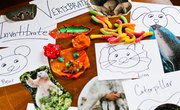Kids and dogs go together like peanut butter and jelly. The natural affinity that a child has with her pet provides a natural connection with a fifth-grade science fair project that involves dogs. Using his own and classmates' dogs, a child can explore questions of canine intelligence and training while learning to better understand his dog's behavior. By working together with friends and their pets, fifth graders can compare the results from different ages, sizes and breeds.
Research Question
A science investigation starts with a question that arises in researching the current knowledge on a given topic. The question focuses the direction of the science project and defines a specific topic for study that can be tested and measured. Read books, articles and websites on the subject of dogs and select a question related to a dog's intelligence or training. For example, "Do dogs have a sense of object permanence?" Other possible questions include, "How quickly can a dog learn a new task?" or, "Do dogs really understand spoken language?"
Hypothesis
A hypothesis statement connects the research question with the expected results by predicting the outcome of the testing. State the prediction in terms of measurable variables. For example, if you want to know if a dog realizes that a treat is still there even when you hide it under a bucket (object permanence), you might predict, "Older dogs will be better than puppies at retrieving a treat hidden under a bucket."
Testing Procedure
Any scientific investigation requires a test that provides observable results for measurement. For example, to test for a dog's sense of object permanence, show the dog a treat and then hide it under a can or bucket. Have the owner tell the dog to retrieve the treat and observe its reaction. Does it knock the can over and get the treat immediately, sniff at the can but lose interest, just walk away or show no interest? If the dog cannot retrieve the treat on the first try, demonstrate for him how to knock the can over and get the treat. Ask the owner to give the retrieve command again and see if the dog can learn to get the treat in three to five tries. Science Buddies cautions that you should never force a dog to participate in an experiment. If it shows no interest in the test, try again later or find another subject.
Results
Scientific knowledge gained through experimentation and investigation is only useful if communicated to the scientific community and the public. Create a chart of each dog's reaction to the test and see whether breed or age shows any influence on the dog's ability. Share your work with others by writing a summary of the background research, question, hypothesis and testing procedure. Include pictures of the dogs and their owners and represent numerical data with colorful graphs for visual interest. You may also choose to make a video record of the dogs during testing to play at your table during the science fair. Arrange the pieces neatly, in chronological order on a tri-fold science fair display board. Be ready to clearly explain to judges what you learned about dogs and their mental capabilities.
Related Articles
References
- Science Buddies; Dog Smarts: What's Going On Behind Those Puppy-Dog Eyes?; Andrew Olson, Ph.D
- Science Buddies; Dog Toys: What Makes One a Favorite or a Flop to Fido?; Darlene E. Jenkins, Ph.D
- Science Buddies; Dog Scents: The Super Nose of Man's Best Friend; Darlene E. Jenkins, Ph.D
- "Science Fair Projects for the Evil Genius"; Dog Science Fair Project - Response to Sounds or Words; Bob Bonnet and Dan Keen; 2009
- "The Complete Handbook of Science Fair Projects"; Are Dogs Colorblind?; Julianne Blair Bochinski; November 2003
Writer Bio
Tamara Christine has written more than 900 articles for a variety of clients since 2010. She holds a Bachelor of Arts in applied linguistics and an elementary teaching license. Additionally, she completed a course in digital journalism in 2014. She has more than 10 years experience teaching and gardening.











